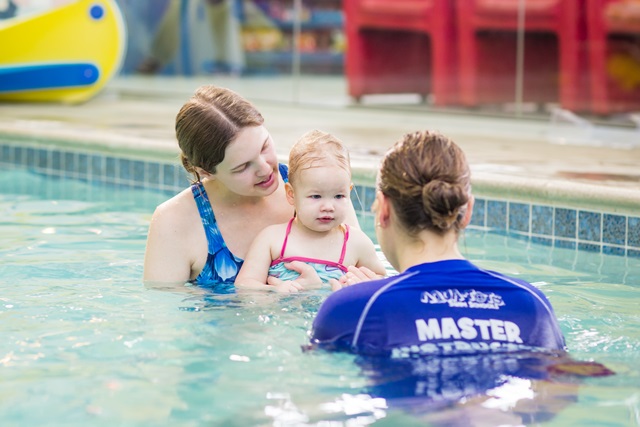
Classes
Children can begin to learn how to swim as early as four months old with parent-child swim classes offered at Aqua Tots. “The parents get in the water and at this point we are getting the child used to the water but then also we are informing the parents this is how you hold your child in the water, these are some of the safety techniques and this is how you can communicate to them,” Cartledge says.
As the child becomes older they can participate in group swim lessons. At Aqua Tots, Cartledge says, “by the time they are two and a half and three, they are on their own with an instructor in the water.” With the young age, one instructor will teach a class of four introductory lessons. “They are learning how to swim, how to swim on their back, they are learning when they touch the bottom of the pool they can push themselves back up and they are learning how to crawl out of a pool.” With more experience, the better the children’s swimming capabilities will be. “The more consistent you are taking active swim lessons and the more repetitive you are with the techniques that you learn, the quicker it will come,” says Cartledge.
If you find that your child has anxiety when it comes to being around water there are different ways you can resolve their worries. The first tip Cartledge provides is “working one-on-one with them and teaching them that water is not going to harm them, that if you fill your lungs with air you are going to float on top.” Another tip when helping children with severe water anxiety is to understand where their fear comes from. “The first step is definitely a one-on-one. Let’s get down to the root cause of the problem and then let’s talk about how we can overcome that,” says Cartledge.
Another important aspect of swimming is breathing. At Aqua Tots, they have specific breathing techniques for beginning swimmers. “The very first thing we learn in our parent-child class is we focus on bubbles because if a child does fall into the water we don’t want them to blow out all their air,” Cartledge says. When concerning a child falling in, Cartledge says, “let’s teach them if they fall in to hold their breath roll over on their back and them take a breath instead of blowing out all of their bubbles.” With these early lessons, children can be better prepared to swim.
